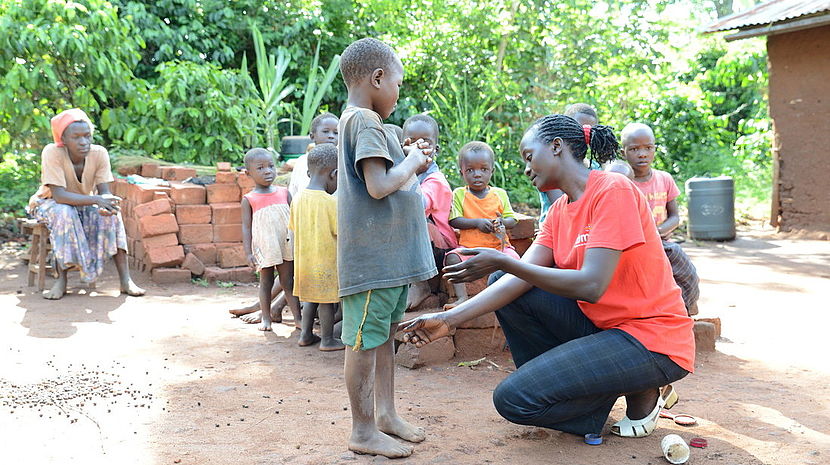Rehabilitation and education in Ethiopia

In this article we highlight our partner Rehabilitation and Prevention Initiative Against Disability (RAPID) in Ethiopia who focusses on community based rehabilitation designed to change negative community attitudes and support children and youth with disabilities to participate and contribute as equal members of their community and economy.
The cycle of poverty and disability in Ethiopia
In Ethiopia disability is commonly associated with a curse. Therefore people with disabilities are regularly excluded from Ethiopian society and discriminated against by their families and communities. There are close to 5.3 million people with disabilities in Ethiopia and only 0.7 per cent have historically had access to educational services.
Approach to disability inclusive development
Recognising the extreme challenges facing people with disabilities in Ethiopia, the Rehabilitation and Prevention Initiative Against Disability (RAPID) began establishing community based rehabilitation (CBR) programs from 2005. The CBR programs are designed to change negative community attitudes and support children and youth with disabilities to participate and contribute as equal members of their community and economy. Today, the CBR programs have reached over 450,000 people in Adama, Assela, Dera and Iteya with CBR activities.
Change at home: RAPID’s CBR programs focus on children under 15 years of age with disabilities, so support is often provided to families in their homes. In Adama, 22 local field workers were trained to help families learn about and understand disability. The field workers conduct rehabilitation in homes, refer children for medical treatment and provide assistive devices to support children to participate in their community. Some parents are given loans and training to help them earn a sustainable income and support their children to go to school.
Change at school: Opening school doors to children with disabilities is one step towards gaining an education, but ensuring they have the right facilities, are accepted and can thrive at school is another. At Adama No.2 Elementary, one of the schools where RAPID is working, special classes are provided for students with disabilities where they learn to use Braille, sign language and other skills to prepare them for transition into mainstream classrooms. Teachers are taught to respond to the needs of students, infrastructure is in place to support students with a disability and a disability club is run for all students, aiming to build understanding and acceptance. Now, when children with disabilities are ready to move into mainstream classrooms, they are welcomed with the right support. In addition to schools, RAPID also supports inclusive practices for livelihood programs, health services, hospitals and local government.
Change in the community: With field workers supporting change in the homes of children with disabilities and teachers embracing disability inclusion in schools, it is important that disability is recognised in the wider community. RAPID has found the most effective way to change community attitudes towards people with disabilities is to focus efforts on training and empowering DPOs, parents’ groups and individuals to advocate for themselves. In each community where the project is run, a CBR committee is set up with parents of children with disabilities, government representatives and local members of DPOs. Together they work to ensure disability is on the community agenda and that people with disabilities have a voice in decision making.
Progress towards inclusion
- During 2012 activities to raise awareness of the causes and prevention of disabilities reached over 51,000 community members.
- Project staff estimate that up to 80 per cent of people are now aware of disability issues and recognise the abilities of people with disabilities.
- Between 2006 and 2009 almost 900 children with disabilities received home based rehabilitation. In 2012, 392 children with disabilities received rehabilitation services.
- In 2012, 736 people were referred for medical treatment.
- During 2012, 468 people were supported to receive assistive and mobility devices.
- 210 people commenced income generation businesses during 2012.
- All parents with a loan interviewed during a 2009 evaluation reported earning a better income.
- Increased numbers of people with disabilities are participating in decision making processes.
- Accessibility of health centres has improved with sign language training so staff can communicate with deaf people.
- Health centres are providing free treatment for people with disabilities.
- A government funded bus now provides transport to rehabilitation services.
Inclusive development in practice
RAPID’s approach highlights two key factors for effective inclusive development:
- Provision of disability specific supports and services to enable participation of people with disabilities in the community
RAPID recognises that physical rehabilitation and provision of assistive devices are vital steps to enable inclusion of youth and children with disabilities in their communities. By providing disability specific support, a strong referral system and services within a wider CBR disability inclusion program, RAPID is making progress towards genuine inclusion and meaningful participation for children and youth with disabilities.
- Advocacy to build awareness of and support for disability inclusion
RAPID’s work with schools is a good example of how utilising a number of strategies can increase awareness and remove barriers blocking disability inclusion. By supporting parent groups, teachers and DPOs to include children and youth with disabilities, and empowering individuals to advocate for themselves according to their own priorities, the project is strengthening the voice of people with disabilities across the community.